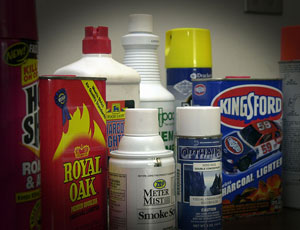What are inhalants?
Inhalants are invisible, volatile chemical vapors inhaled to induce psychoactive or mind-altering effects. They are found in common household products such as glue, gasoline, lighter and cleaning fluid and paint. Less obvious inhalants include typewriter correction fluid, computer air duster, fingernail polish remover, paint thinner, air conditioning refrigerant, felt tip markers, air freshener and butane.
Common names are Gluey, Huff, Rush, and Whippets.
What do inhalants look like?
There are more than 1,000 legally available products being abused outside of their intended uses.
How are inhalants abused?
Inhalants are breathed in through the nose or mouth by sniffing/snorting directly, bagging or huffing. Bagging is inhaling fumes from substances inside a plastic or paper bag. Huffing refers to either stuffing inhalant-soaked rags in the mouth or directly inhaling from nitrous oxide filled balloons. Dusting involves breathing in computer air duster fumes through the nose or mouth.
Inhalants are often among the first drugs used by children, and one in five kids report using inhalants by the eighth grade.
How do inhalants affect a person?
Inhalants cause slurred speech, lowered inhibitions, lack of coordination and unconsciousness.
What are the health effects/risks of using inhalants?
Prolonged use leads to weight loss, muscle weakness, disorientation, inattentiveness, lack of coordination, irritability, depression and damage to the nervous system. Inhalants such as butane, propane and chemicals in aerosols commonly induce irregular and rapid heart rhythms or respiratory obstruction, sometimes leading to death within minutes.
Some inhalants cause more severe long-term effects including liver and kidney damage, hearing loss, bone marrow damage, limb spasms and brain damage. Many effects from prolonged abuse are irreversible.
Frequent inhalant use over a short time span can lead to death by asphyxiation.
